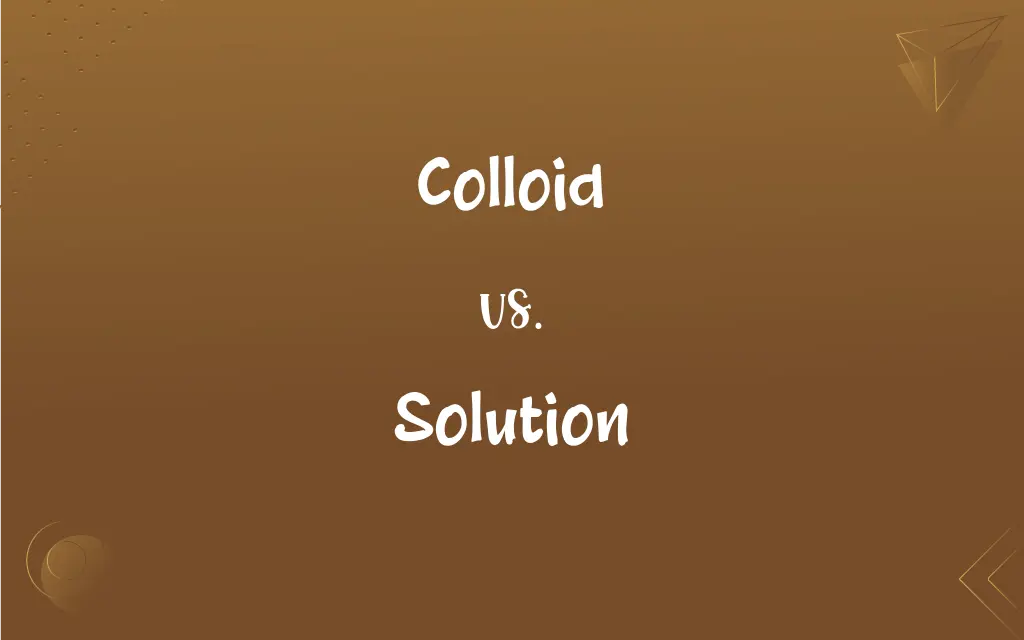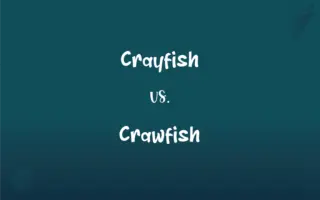Colloid vs. Solution: What's the Difference?
Edited by Aimie Carlson || By Janet White || Published on December 20, 2023
A colloid is a mixture where one substance of microscopically dispersed insoluble particles is suspended throughout another substance, whereas a solution is a homogeneous mixture where a solute is dissolved in a solvent.

Key Differences
Colloids consist of two distinct phases: the dispersed phase (particles) and the continuous phase (medium), which coexist without dissolving completely. In contrast, a solution is a single phase where the solute particles are completely dissolved in the solvent, forming a uniform mixture.
The particles in a colloid are larger than those in a true solution, often ranging from 1 to 1000 nanometers in size. Solutions, on the other hand, have solute particles that are much smaller, typically at the molecular or ionic level, and are not visible under a microscope.
Colloids exhibit the Tyndall effect, where light is scattered by the larger particles, making the light beam visible in the colloid. Solutions do not show the Tyndall effect as their particles are too small to scatter light.
Stability differs between colloids and solutions. Colloids can be relatively unstable and may separate over time, while solutions are typically stable and the solute does not settle out or separate from the solvent.
Examples of colloids include fog, milk, and jelly, where the different substances are mixed but not dissolved. Solutions include salt water and sugar dissolved in water, where the solute is completely dissolved and indistinguishable from the solvent.
ADVERTISEMENT
Comparison Chart
Particle Size
1-1000 nanometers
Molecular or ionic level
Visibility
Particles visible under microscope
Particles not visible
Tyndall Effect
Exhibits Tyndall effect
No Tyndall effect
Stability
May separate over time
Generally stable
Examples
Fog, milk, jelly
Salt water, sugar in water
ADVERTISEMENT
Colloid and Solution Definitions
Colloid
A mixture with particles suspended in a continuous medium.
Mayonnaise is a colloid, as it contains oil droplets dispersed in water.
Solution
A homogeneous mixture of two or more substances.
Salt dissolved in water forms a solution.
Colloid
A system where fine particles are suspended in a fluid where they are supported by buoyancy.
Whipped cream is a colloid with air bubbles trapped in cream.
Solution
A liquid mixture in which the minor component (the solute) is uniformly distributed within the major component (the solvent).
Coffee is a solution of water and various dissolved compounds.
Colloid
A substance where microscopic particles are evenly dispersed throughout another material.
Smoke is a colloid consisting of solid particles in air.
Solution
A mixture where a solute is dissolved in a solvent.
Sugar dissolved in tea is a solution.
Colloid
A heterogeneous mixture that does not settle or separate.
Gelatin is a colloid, with water evenly distributed in a network of proteins.
Solution
A mixture that forms when one substance dissolves another.
A solution of vinegar is formed when acetic acid dissolves in water.
Colloid
A mixture where one substance is dispersed evenly throughout another.
Paint is a colloid, with pigment particles evenly dispersed in a liquid medium.
Solution
A uniform mixture of molecular or ionic species.
Alcohol in water is a solution, with alcohol molecules evenly distributed in water.
Colloid
A system in which finely divided particles, which are approximately 1 to 1,000 millimicrons in size, are dispersed within a continuous medium in a manner that prevents them from being filtered easily or settled rapidly.
Solution
A method or process of dealing with a problem
Sought a solution to falling enrollments.
Colloid
The particulate matter so dispersed.
Solution
The answer to a problem or the explanation for something
The solution to the mystery.
Colloid
The gelatinous stored secretion of the thyroid gland, consisting mainly of thyroglobulin.
Colloid
Gelatinous material resulting from degeneration in diseased tissue.
Colloid
Of, relating to, containing, or having the nature of a colloid.
Colloid
Glue-like; gelatinous.
Colloid tumours
Colloid
(chemistry) A stable system of two phases, one of which is dispersed in the other in the form of very small droplets or particles.
Colloid
(meteorology) An intimate mixture of two substances, one of which, called the dispersed phase (or colloid), is uniformly distributed in a finely divided state throughout the second substance, called the dispersion medium (or dispersing medium).
Colloid
(geology) A particle less than 1 micron in diameter, following the Wentworth scale
Colloid
Resembling glue or jelly; characterized by a jellylike appearance; gelatinous; as, colloid tumors.
Colloid
A substance (as albumin, gum, gelatin, etc.) which is of a gelatinous rather than a crystalline nature, and which diffuses itself through animal membranes or vegetable parchment more slowly than crystalloids do; - opposed to crystalloid.
Colloid
A gelatinous substance found in colloid degeneration and colloid cancer.
Colloid
A mixture with properties between those of a solution and fine suspension
FAQs
How is a solution different from a colloid?
In a solution, the solute dissolves completely in the solvent, forming a homogeneous mixture, unlike a colloid.
What is the Tyndall effect in colloids?
The Tyndall effect is the scattering of light by colloidal particles, making a light beam visible in the colloid.
What defines a colloid?
A colloid is a mixture where small particles are suspended throughout a continuous medium without dissolving.
What are examples of colloids in daily life?
Examples include milk, mayonnaise, and fog.
Are solutions always liquid?
No, solutions can be gases, liquids, or solids, but the most common solutions are liquid.
Can colloids be separated into their components?
Yes, colloids can be separated by methods like centrifugation or filtration.
Do solutions exhibit the Tyndall effect?
No, solutions do not show the Tyndall effect as their particles are too small to scatter light.
Can the particles of a colloid be seen with the naked eye?
No, colloidal particles are too small to be seen with the naked eye but can be detected under a microscope.
What are examples of solutions?
Common examples include salt water, sugar in tea, and carbonated beverages.
Can the solute in a solution settle out over time?
No, in a stable solution, the solute does not settle out or separate from the solvent.
Are colloids always liquid?
No, colloids can be in gaseous, liquid, or solid states.
What role does temperature play in solutions?
Temperature can affect the solubility of the solute in a solution, often increasing solubility with higher temperatures.
Do colloids conduct electricity?
It depends on the nature of the colloidal particles; some may conduct electricity, while others do not.
Can the concentration of a solution be changed?
Yes, by adding more solute or solvent, the concentration of a solution can be altered.
What is a saturated solution?
A saturated solution is one in which no more solute can be dissolved at a given temperature and pressure.
How is the stability of a colloid measured?
Stability of colloids can be measured by observing if and how quickly the particles settle or aggregate.
How are colloids different from suspensions?
Colloids have smaller particles that don't settle out quickly, unlike suspensions where particles can settle over time.
Is it possible to separate the components of a solution?
Yes, through processes like evaporation or distillation, the components of a solution can be separated.
What is the role of a solvent in a solution?
The solvent is the component of a solution that dissolves the solute, typically present in a larger amount.
Can colloids be colored?
Yes, colloids can be colored if the dispersed phase or the continuous phase has color.
About Author
Written by
Janet WhiteJanet White has been an esteemed writer and blogger for Difference Wiki. Holding a Master's degree in Science and Medical Journalism from the prestigious Boston University, she has consistently demonstrated her expertise and passion for her field. When she's not immersed in her work, Janet relishes her time exercising, delving into a good book, and cherishing moments with friends and family.
Edited by
Aimie CarlsonAimie Carlson, holding a master's degree in English literature, is a fervent English language enthusiast. She lends her writing talents to Difference Wiki, a prominent website that specializes in comparisons, offering readers insightful analyses that both captivate and inform.






































































